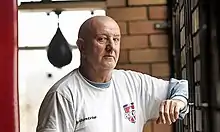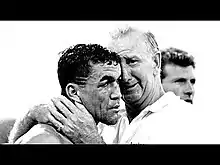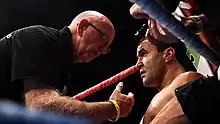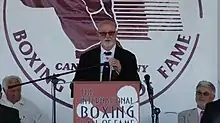Johnny Lewis (boxing trainer)
John Alfred “Johnny” Lewis OAM (born 18 March 1944) is an Australian boxing trainer and the head coach of six world champions, most notably Jeff Fenech, Jeff Harding, Gairy St. Clair and Kostya Tszyu.[1]
| John Alfred Lewis | |
|---|---|
 Johnny Lewis at Newtown Boxing Club, 2017 | |
| Statistics | |
| Nickname(s) | Johnny |
| Nationality | Australian |
| Born | 18 March 1944 Erskineville, New South Wales, Australia |
Lewis’ career spans from training amateur boxers on the local Sydney circuit to working with Australian boxing champions and rugby league international representatives.[2] The philosophies and coaching career of Lewis merited him many accolades including an Order of Australia medal and an induction into the International Boxing Hall of Fame, both of which were achieved in 2006.[3] Due to these accolades, Johnny Lewis has been asserted as one of Australia's most acclaimed boxing coaches.[4][2]
Early life
Johnny Lewis was born on 18 March 1944 at Bankstown hospital to father Alfred and mother Marge.[5] His family lived in Wallangarra at the time, before moving into a housing commission flat in Erskineville, in Sydney's inner-west.[5][6]
Lewis' first employment was selling papers at Football games as well as working the scoreboard at Erskineville Oval for local first-grade Australian Rules matches, where he would listen to coaches’ team talks.[5] Lewis played Australian Rules Football and Tennis throughout his teenage years.[7] An athletic career for Lewis was cut short at age 19 as he sustained an ankle injury after falling off a ladder whilst sign writing.[5]
In 1957, a thirteen-year-old Lewis began training under coaches Snowy MacFadyen and Jack Blom at the Newtown Police Boys Club, travelling to Cowra, Orange, Griffith and Singleton in regional New South Wales for amateur boxing competitions.[5][8] As a physically disadvantaged boxer Lewis trained under Dick O’Connor until he was 17, without losing a fight under his guidance.[5][9] Lewis models much of his coaching style on O’Connor's.[5][9]
Amateur coaching career
Lewis’ introduction to coaching came by coincidence - at age 17 as his coach Ken Shorter, assigned Johnny to corner six amateur boxers at a tournament in Parramatta, all of which won their respective bouts.[5] In 1961 Johnny took over the Newtown PCYC boxing club as its head trainer.[10] A year later Snowy McFaden would re-enter the gym, training alongside Lewis for 3 years.[5]
In 1966 Lewis moved to the Botany Street gym in partnership with Mick Fernandez, where Fernandez would train professional fighters and Lewis would train the amateur fighters.[5][11]
Fernandez taught Lewis how to wrap hands and clean cuts.[5][10] Later Lewis would incorporate Fernandez into Snowy Robbin's gym in Erskineville.[7]
In 1978, Phil McElwaine won a gold medal in the middleweight division at the Commonwealth Games in Edmonton, Canada with Lewis in his corner.[12]
In November 1988, Lewis was appointed head trainer for the Australian Amateur Boxing Team for the Seoul Olympics.[13]
Young Offenders Program
In January 1986, Lewis took several of his fighters including Jeff Fenech to Parklea Prison to spar inmates in makeshift rings, the point of which was to demonstrate the outcomes of poor behaviour for his fighters and an appropriate outlet of aggression for the prisoners.[14]
Brian Moore started the Young Offenders Program in the Newtown Police Boys Club.[15] Lewis would join this partnership by continuing to take boxers to prisons across New South Wales.[5] As the program developed it became more theoretical, boxers would spar less and instead hand out Big League Magazines and videos of boxing matches.[16]
Professional coaching career
Summary
The professional career of Lewis catalysed due to the rapid rise of Jeff Fenech.[7] This in turn caused Jeff Harding to relocate from Grafton to train under him and Russian World Amateur Champion Kostya Tszyu to turn professional under Lewis’ tutelage.[17][18] These accreditations prompted several fighters to also be trained by Lewis.[5][2]
Virgil Hill
American Virgil Hill moved to Australia to train at Newtown in an attempt to regain his world light-heavyweight title.[19] In 1992 was Hill's third fight under Lewis, in which he won a unanimous decision against Frank Tate to gain the vacant WBA light heavyweight title.[20] This was a short-term partnership however as Hill returned to the United States after the victory.[5][21]
Joe Bugner
In 1986, Joe Bugner came out of retirement for one last campaign, aiming to fight heavyweight champion Mike Tyson.[5] In moving to Australia, Bugner went on a three-fight win streak before stopped in the eighth round by Frank Bruno.[22] Bugner had domestic success after his partnership with Lewis, winning the Australian Heavyweight title.[23]
At the peak of Bugner's comeback, he won a unanimous decision against Greg Page in Sydney.[24] On this card, Johnny Lewis had Jeff Harding finish Johnny Tapau Sr in the second round and Peter Mitrevski winning a decision over Charlie Brown.[5]
Justin Rowsell
Following the 1992 Olympics, Justin Roswell, a promising Australian amateur turned professional under Lewis, winning the WBO intercontinental lightweight championship.[25] Rowsell had a more acclaimed amateur career however, with a bronze medal at the 1991 Amateur Boxing World Championships, a gold medal at the Canada Cup and a Commonwealth games silver medal.[26]
Gairy St. Clair
In his training with Lewis, Gairy St. Clair won the International Boxing Federation and International Boxing Organization World Super Featherweight Title in South Africa,[27][28] winning a unanimous decision 116–112, 115–113, 115–114 over Cassius Baloyi.[29] Lewis regarded St Clair as not only one of the best movers he'd trained but seen.[5]
Billy Dib
Billy Dib would win his first world title, the IBO Super-featherweight championship in 2008 against Zolani Marali after switching trainers to have Lewis in his corner.[10] Whilst a brief training partnership, Dib became Johnny Lewis’ sixth World Title holder.[30]
Jeff Malcolm
Jeff Malcolm was managed by New South Wales Blues and Australian Kangaroos Rugby League representative Tommy Raudonikis whilst being trained by Johnny Lewis.[5] Lewis trained Malcolm for sixteen years, holding the Australian Super Lightweight Title before relocating to the United States in the quest for a world title.[31]
Peter Mitrevski
Peter Mitrevski won the vacant Australian flyweight title against Charlie Brown in 1988 under the training of Lewis.[32] Lewis stated Mitrevski may not go any further in the sport of boxing, suggesting his retirement.[5] Mitrevski was upset by this statement however stayed with Lewis due to his friendship with Jeff Fenech.[5][33]
Paul Briggs
Paul Briggs asked Lewis to take over his training after a majority decision loss to Tomasz Adamek for the WBC Light Heavyweight title.[34] After the training of Lewis, Briggs got his rematch against Adamek, only to lose again via majority decision.[35] After this loss, Lewis began to reduce training fighters, giving time to his family.[5][10]
Jeff Fenech
Lewis met Jeff Fenech in 1981, when Fenech came in to the Newtown boxing gym for Rugby League fitness.[36] Fenech was cornered by Lewis since his professional debut at Blacktown Police Boys Club, with a win over Craig Easey.[37] Lewis was unimpressed by Fenech's fighting style in the early years and tried to implement discipline in Fenech's life in and out of the ring.[5][36] By this time, Lewis was 37 years-old and had over 20 years of experience training boxers.[5][2] After winning a bronze medal at the 1983 Rome World Cup and captaining the Australian amateur team in the 1984 Olympics Fenech would turn professional under Lewis the following year.[38] Fenech stopped Junior Thompson in the fourth round to win the Australian super-fliyweight title in his third fight.[39] With struggles to cut down to the 115-pound junior bantamweight division, Lewis moved Fenech up to bantamweight.[40][36] Lewis aimed to match Fenech up against different styles to concentrate on one aspect of the sport at a time.[7][18] This was evidenced by Fenech's matchup against Rolly Navarro, a southpaw. Despite dominating the fight, Lewis ordered Fenech to keep the fight going for his experience.[5][4]

Fenech vs Shingaki
After only 7 consecutive wins to start his career Fenech would win the IBF World bantamweight title against Satoshi Shingaki.[37] Johnny Lewis and manager Bill Mordey accepted a rematch with Shingaki in order to stall top contender Jerome Coffee and give Fenench more experience.[5] In the rematch Fenech broke Shingaki's nose in the first round before stopping him in the third.[41]
IBF Title Defences
Jeff Fenech went 15 rounds with American contender Jerome Coffee before being awarded a unanimous decision victory, 148–140, 146–141 and 145–140.[37][42] After the title defence, Lewis would have Fenech train under shadow boxing conditions due to broken hand injuries.[38][5]
Fenech would defend the IBF title against Steve McCrory, despite being dominated in the latter rounds, almost forcing Lewis to throw the towel in.[5][43]
Fenech vs Payakaroon
Fenech would knock out Samart Payakaroon in the fourth round to win the WBC Super bantamweight title.[37]
WBC Title Defences
Fenech earned a technical decision victory over Carlos Zarate after a cut was patched up by Lewis in between rounds.[44]
Lewis notoriously demoralised opponents by picking up his fighter and pushing him toward the centre of the ring before the beginning of each round.[5][10][11] Lewis would do this in Fenech's career against Victor Callejas earning him a victory and Azumah Nelson for a split decision draw.[37][5][45]
Fenech would lose a rematch against Nelson,[37] Lewis would only not retire his fighter as he felt he deserved a better ending.[5]

Lewis led Fenech to three world titles at bantamweight, featherweight and super featherweight respectively.[10][46]
Jeff Harding
Jeff Harding was introduced to Lewis at the 1984 Olympics. Lewis moved Harding up to Light Heavyweight permanently after his New South Wales Cruiserweight title victory in 1988.[4]
In his first fight outside Australia Harding defeated Dennis Andries, trained by Hall of Fame trainer Emmanuel Steward solidifying Lewis amongst the elite boxing trainers.[47][5] Before the final round, it was revealed that Lewis said “go out one more time and come back world champion.”[5][6][10][47]
Kostya Tszyu
In coaching the Australian amateur team at the World Championships in Moscow, Lewis met Russian Lightweight Kostya Tszyu. Tszyu would move to Australia permanently to train under Lewis and after an impressive knockout streak that would move him up the professional ranks toward light-welterweight contention.[48]
Tszyu would capture the IBF light-welterweight title in January 1995 against Jake Rodriguez.[49] In 2001, Tszyu would defeat Zab Judah to become the WBC, WBA and IBF champion.[50] Revealed in his biography by Paul Kent, Lewis would feel a rift with Tszyu after allegedly being underpaid.[51][52] Further revelations involved the attempts of Lewis to depart as head coach, feeling as if he was not needed in the Tszyu camp.[5][53][54]

Philosophies
Lewis would tape a white cross on each of his fighter's wrists, one for him and one for his opponent so they may be watched over during the fight.[18] He would say “we want them all to go down, but we want them all to get up after the count of ten.”[18][5][10]
In his early 20s Lewis journeyed to Thailand and witness the fighters hitting target pads.[5][18] After noticing the difference in speed that Thai boxers possessed, he would implement pads into his gym at Newtown.[55] Target pads were seen in all boxing gyms in Australia since then, formerly coaches used larger gloves as the target.[5]
Lewis would say “I love you” to all his fighters, sending them out for the next round – revealed in his biography that he was looking for “trust”.[5] Further corner work would involve Lewis pushing his fighter to the middle of the ring before the round began to exhibit a quick recovery and high work rate to demoralise the opponent.[4][10]
Lewis used a personal solution with a Friars' balsam base to stop cuts and peppermint oil for fighters to sniff before and during the fight for breathing purposes.[5]
Lewis highlighted the importance of high intensity training, likening it to a marathon as it would be easier if run in stages.[5][18]
Honours

In December 1989, Johnny Lewis was named Coach of the Year at the Sport Australia Awards.[56] At the time, Lewis had two concurrent champions in his gym and held a record of 13–0 in title fights.[2][5][17]
In 2006, Lewis was awarded the Medal of the Order of Australia[11] and inducted into the Boxing Hall of Fame.[3][10][18]
Rugby league

Lewis had been on the Newtown Jets Rugby League Club committee since 1973, when Jack Gibson was appointed coach.[7] Newtown's captain, Tommy Raudonikis trained with Lewis for extra fitness sessions.[57]
In 1989, through rugby league international player, coach and personal friend Bob Fulton, Lewis became a trainer of the Australian Kangaroos 1990 Tour of Great Britain and France.[2][5][58]
Personal life
Lewis has lived in Erskineville his whole life,[59] working as a signwriter for the Sydney County Council for majority of it, whilst simultaneously training fighters. Lewis has four children, Brent, Leisa, Jackson and Johnnie Jr.[5]
Lewis operated the Newtown Police Boys Club Boxing gym alongside childhood friend and Newtown Jets centre, Brian Moore.[5]
In April 1999, a hailstorm caused damage to the roof of the Newtown Police Boys Club with repairs costing an approximate one million dollars, the Inner West Council put the building up for sale.[5][60] At age 61, the gym closure forced Lewis to train fighters at PCYC institutes in Woolloomooloo, South Sydney and Marrickville as well as the HK Ward University of Sydney boxing gym.[61]
References
- Falcous, Mark; Anderson, William (1 October 2011). "Fighting whose corner? Boxing, the sports press and the Australian imagination". Continuum. 25 (5): 743–753. doi:10.1080/10304312.2011.590730. ISSN 1030-4312. S2CID 145272277.
- Becker, David; Hill, Scott (2010). The coaches. Sports wisdom revealed (1st ed.). Caloundra, Qld: Revealed Series (Australia). ISBN 978-0-9807672-0-9.
- Roberts, James B; Skutt, Alexander G.; Fame, International Boxing Hall of (2011). The boxing register : International Boxing Hall of Fame official record book (Fifth ed.). Ithaca, N.Y. : McBooks Press. ISBN 978-1-59013-502-0.
- Kieza, Grantlee (1 October 2015). Boxing in Australia. National Library of Australia. ISBN 978-0-642-27874-6.
- Kent, Paul (2010). Johnny Lewis: The biography: The story of Australia's king of boxing. Allen & Unwin. ISBN 978-1-74269-089-6.
- Heather, McNab (27 July 2017). "Johnny Lewis reflects on his brilliant career". www.dailytelegraph.com.au. Retrieved 28 May 2020.
- Kieza, Grantlee (18 May 2013). "Legendary boxing trainer Johnny Lewis talks boxing, rugby league and Kostya v Fenech". www.couriermail.com.au. Retrieved 28 May 2020.
- Pfeiffer, Elise (9 February 2018). "Show time for PCYC boxers". The Singleton Argus. Retrieved 28 May 2020.
- Wacquant, Loïc J.D. (1995). "Pugs at Work: Bodily Capital and Bodily Labour among Professional Boxers". Body & Society. 1 (1): 65–93. doi:10.1177/1357034x95001001005. ISSN 1357-034X. S2CID 145591779.
- Kieza, Grantlee (7 December 2016). "Johnny Lewis into Boxing Hall of Fame". Fox Sports. Retrieved 28 May 2020.
- Ellis, Brock (14 June 2017). "A Moment of Great Pride: The Induction of Johnny Lewis into the IBHOF". Aus-Boxing.com. Retrieved 28 May 2020.
- Simpson, Lindsay; Cooke, Jennifer (25 January 2008). "Fearless chronicler of crime". The Sydney Morning Herald. Retrieved 28 May 2020.
- Australian Olympic Committee (2003). "The Compendium: Official Australian Olympic Statistics 1896-2002". Univ. Of Queensland Press.
- Community Relations Division, freecall 1800 685 449; Justice, NSW Department of. "Evaluation of PCYC Young Offender programs". www.bocsar.nsw.gov.au. Retrieved 28 May 2020.
- Ringland, Clare (2016). "Participation in PCYC Young Offender programs and re-offending". NSW Bureau of Crime Statistics and Research.
- Russo (27 October 2014). "RIP Brian 'Chicka' Moore". Newtown Jets. Retrieved 28 May 2020.
- Forrer-Arnold. "Lewis trains boxing champions". Morning Bulletin. Retrieved 28 May 2020.
- Webster, Andrew (12 June 2017). "Australian trainer Johnny Lewis inducted into Boxing Hall of Fame". The Sydney Morning Herald. Retrieved 28 May 2020.
- "VIRGIL HILL: THERE'S NO PLACE LIKE HOME". TOPCLASSBOXING. 19 November 2018. Retrieved 28 May 2020.
- news@grandforksherald. com | Feb 14th 2013 - 2pm (14 February 2013). "Virgil Hill wants one last fight in North Dakota". Grand Forks Herald. Retrieved 28 May 2020.
- "Lewis adds honour to his four titles". The Sydney Morning Herald. 26 January 2006. Retrieved 28 May 2020.
- Blog, That 1980s Sports (21 June 2012). "That 1980s Sports Blog: 1987: Frank Bruno v Joe Bugner". That 1980s Sports Blog. Retrieved 28 May 2020.
- "Bugner, 45, Returns to Win Australian Title". Los Angeles Times. 23 September 1995. Retrieved 28 May 2020.
- Kieza, Grantlee (7 March 2015). "The man who punched Ali in the face". www.couriermail.com.au. Retrieved 28 May 2020.
- Spinks. "Gloves off for Rowsell". Northern Star. Retrieved 28 May 2020.
- Turnbull (1 February 2016). "Australia's best boxers condemn one-punch attacks". www.abc.net.au. Retrieved 28 May 2020.
- Nicolussi (25 February 2010). "Fight cancelled after Lewis nightmare". www.dailytelegraph.com.au. Retrieved 28 May 2020.
- "Lewis challenges St Clair". www.dailytelegraph.com.au. 31 January 2008. Retrieved 28 May 2020.
- "BoxRec: Gairy St Clair". boxrec.com. Retrieved 28 May 2020.
- Nicolussi (31 July 2008). "Moment Dib knew title was his". www.dailytelegraph.com.au. Retrieved 28 May 2020.
- Pritchard-Nobbs (21 November 2007). "Jeff "Flash" Malcolm - Evergreen Road Warrior! • East Side Boxing • News Archives". Boxing News Archives. Retrieved 28 May 2020.
- "BoxRec: Peter Mitrevski". boxrec.com. Retrieved 28 May 2020.
- "Fenech in stitches after 'argument'". www.heraldsun.com.au. 16 February 2009. Retrieved 28 May 2020.
- "BoxRec: Paul Briggs". boxrec.com. Retrieved 28 May 2020.
- admin (18 April 2020). "How a world title loss saved the life of Paul Briggs". Aus-Boxing.com. Retrieved 28 May 2020.
- Kieza, Grantlee; Muszkat, Peter (1988). Fenech, the official biography. Sydney: Lester-Townsend. ISBN 978-0-949853-15-8.
- "BoxRec: Jeff Fenech". boxrec.com. Retrieved 28 May 2020.
- Fenech, Jeff; Smith, Terry (1993). Jeff Fenech: I love youse all. Baxter, Vic: Modern Publishing Group. ISBN 978-1-875481-37-8.
- Lafferty, Yvonne; McKay, Jim (1 September 2004). ""Suffragettes in Satin Shorts"? Gender and Competitive Boxing". Qualitative Sociology. 27 (3): 249–276. doi:10.1023/B:QUAS.0000037618.57141.53. ISSN 1573-7837. S2CID 144317809.
- "How Jeff Fenech lost 22kgs". www.dailytelegraph.com.au. 21 June 2008. Retrieved 28 May 2020.
- "Best I Faced: Jeff Fenech". The Ring. 6 January 2017. Retrieved 28 May 2020.
- "Fenech at home among boxing's elite". www.dailytelegraph.com.au. 5 August 2009. Retrieved 28 May 2020.
- Dewhurst (1986). "Australian Jeff Fenech knocked out Olympic gold medalist Steve..." UPI. Retrieved 28 May 2020.
- Zanon (2019). "The Peoples Champion Jeff Fenech Salutes His Fans". hannibalboxing.com. Retrieved 28 May 2020.
- Morrison, J (1995). The Professor. Viva Voce.
- "Jeff Fenech". www.sahof.org.au. Retrieved 26 September 2020.
- Kieza, Grantlee (12 November 2016). "When an Aussie showed Trump how to win". www.couriermail.com.au. Retrieved 28 May 2020.
- "Kostya Tszyu". www.sahof.org.au. Retrieved 26 September 2020.
- Goodwin, E. "Arnold Thomas Collection | National Library of Australia". www.nla.gov.au. Retrieved 28 May 2020.
- "BoxRec: Kostya Tszyu". boxrec.com. Retrieved 28 May 2020.
- Kent, Paul (2015). "Sonny Ball by Paul Kent - 9781743534212 - QBD Books". www.qbd.com.au. Retrieved 28 May 2020.
- "Tszyu's cash fight". 13 November 2007. Archived from the original on 13 November 2007. Retrieved 28 May 2020.
- Fried, Jeffrey (2004). "The Sweet Science: Legally Speaking (Professional Boxing)". Journal of Legal Aspects of Sport. 14: 75–112. doi:10.1123/jlas.14.1.75.
- "I made the right call, claims defiant Lewis". The Sydney Morning Herald. 9 June 2005. Retrieved 28 May 2020.
- Iskenderov, Parviz (13 June 2017). "Johnny Lewis inducted into International Boxing Hall of Fame". FIGHTMAG. Retrieved 28 May 2020.
- "Johnny Lewis". www.sahof.org.au. Retrieved 26 September 2020.
- "The Best Tommy Raudonikis Yarn You'll Ever Hear". Triple M. Retrieved 28 May 2020.
- Hutchins, Brett; Mikosza, Janine (1998). "Australian rugby league and violence 1970 to 1995: a case study in the maintenance of masculine hegemony". Journal of Sociology. 34 (3): 246–263. doi:10.1177/144078339803400303. ISSN 1440-7833. S2CID 144491457.
- Bell, Matthew (2019). "Marrickville marital home of boxing trainer Johnny Lewis hits the market - realestate.com.au". www.realestate.com.au. Retrieved 28 May 2020.
- "$6 million man and the kids who dance". The Sydney Morning Herald. 1 August 2002. Retrieved 28 May 2020.
- Clyde-Smith, D (26 May 2011). "The spirit of Marrickville: Johnny Lewis". Off Campus. Retrieved 28 May 2020.
External links
- Johnny Lewis: The biography. Story of Australia's King of Boxing Biography by Paul Kent